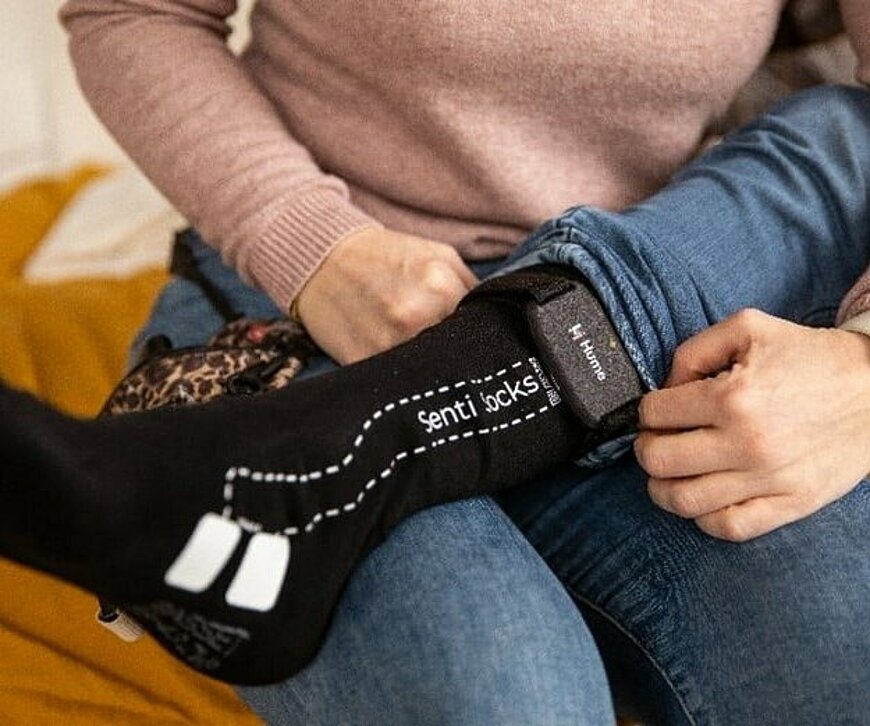HUME gives vulnerable people a voice by making their stress levels visible

Photo from © Philadephia
HUME is a digital system that measures stress based on sensors in wearables and smart algorithms.
Vulnerable people, such as those with dementia or intellectual disabilities, sometimes exhibit misunderstood behavior due to stress. And stress is measurable, with the help of the right technology. HUME, developed by Mentech Innovation, is a digital system that measures stress based on sensors in wearables and intelligent algorithms. The company, founded in 2018, is currently making great strides. “By now, more than thirty healthcare institutions are using HUME,” says Erwin Meinders, the company’s founder.
How is your company doing at the moment?
We are currently busy scaling up within long-term care in the Netherlands. The intelligent sock, the wearable that measures stress based on skin conductivity, is robust and well integrated into the primary process. We are also introducing new wearables to make HUME more widely applicable. For example, we recently presented the wrist variant of the HUME at the Care & ICT Exhibition in Utrecht. We are also taking steps toward intervention. We are linking stress prediction to an intervention strategy. On the one hand, we do this through the HUME app, which shows the intended intervention in addition to the “traffic light. On the other hand, we link the HUME stress prediction to an autonomous care robot, strategically collaborating with SARA Robotics. We collect data through HUME sensors and transmit it to the emotion-intelligent robot, providing person-centered care and support.”
Infobox: how it works
Mentech’s wearables measure physiological parameters, such as heart rate, skin conductance (which indicates stress, like sweat), and a person’s activity. The physiological data are converted into stress levels through smart, trained algorithms, displayed as a traffic light on a smartphone (for early warning) or as data in a dashboard (for diagnostics). The HUME was clinically validated in 2020 and has been deployed in long-term care in the Netherlands since early 2021.
In what areas do you help advance healthcare?
“Our product demonstrably increases the quality of life; of both people who need long-term care and the care workers themselves. Because people are better understood, there is less stress and, therefore, less staff turnover and attrition. That reduces costs on the staffing side.”
Can you describe a specific situation where someone benefited from HUME?
“We used HUME for over six months with a young adult woman with an emotional developmental level of two months. During this time, the team performed at peak performance. Previously, escalations were occurring daily, resulting in fixations and self-harm. Employees were out of work for long periods because they became ill from these escalations. Through the deployment of HUME, it became clear that this woman greatly needed attention, security, contact, and hugs. Care workers can now give her what she needs. There are no more escalations, the father is getting kisses again, and staff are eager to work with her again.”
Highlights
Mentech Innovation’s HUME measures stress levels in people (incapacitated or not) with dementia or intellectual disabilities.
The company does this using wearable sensors (such as the smart sock or wristband) and trained algorithms
What do your future plans look like?
“We are ‘champion stress measurement.’ You can measure stress in people with misunderstood behavior and other target groups. That is why we are investigating how to use HUME with healthcare employees and other stressful professions. In addition, with wearables and smart algorithms, you can also measure pain or addiction symptoms.”
When are you satisfied; When is the mission accomplished?
“I dream that everyone in long-term care – and eventually everyone outside – has a digital buddy who is always on and can provide structural help. That doesn’t necessarily have to be a robot; it can also be a hologram or a smart hug. I expect healthcare to start using data and tools more and more eventually.”
